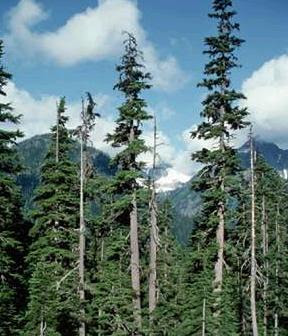Spruce
Spruce Spruce, common name for a genus of about 40 species of coniferous trees, indigenous to the northern hemisphere, nearly half being natives of North America. The genus, of the pine family, was formerly combined with a fir genus, from which it differs in having pendulous cones, persistent woody leaf-bases, and four-angled leaves, scattered and pointing in every direction. Spruces occur farther north than most trees, forming forests within the Arctic Circle, and extending south, especially in the mountains, as far as the Pyrenees in Europe and the Himalayas in Asia; in the United States, spruces occur as far south as North Carolina and Arizona. The white spruce and black spruce cover extensive areas in Canada, almost to the total exclusion of other trees. In Europe the Norway spruce is similarly distributed; the timber is valuable for fuel and for house building and is exported from Norway and Sweden for masts and spars of sailing vessels. Scientific classification: Spruces make up

